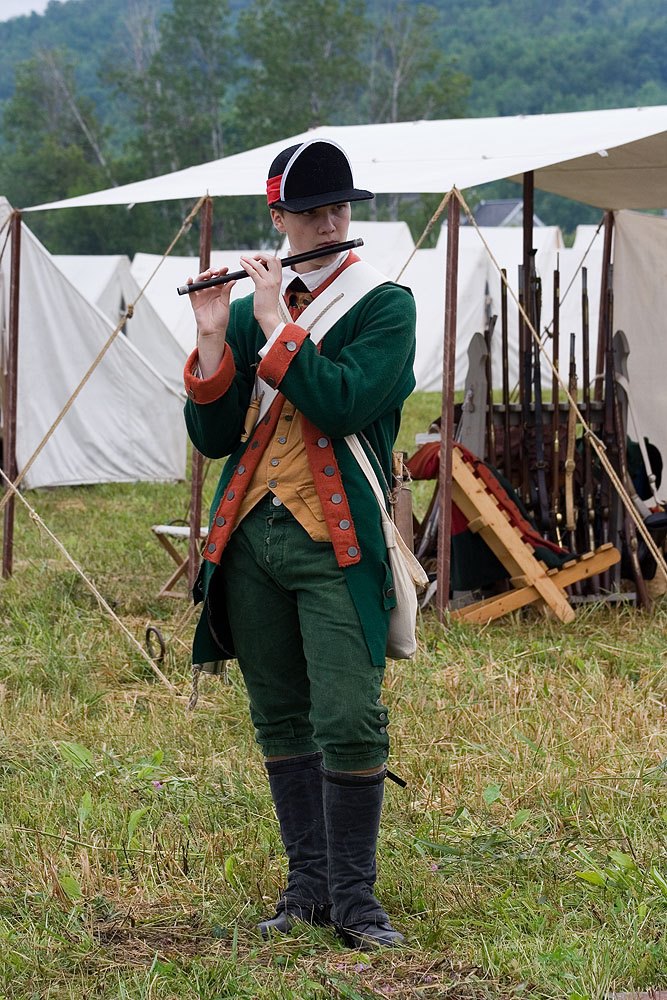
Battlefield Signals
Simes1 & later, von Steuben2 have listed specific drum signals for maneuvering on the field. However, there is great debate of how musical signals were actually used in the field. A number of signals which while useful for training or on parade, they certainly would be less than practical for combat situations. Anyone with military experience will attest what is written in the manuals does not always translate effectively to the battlefield. Regardless, Samuel Dewees3 notes in his journal:
In going into battle it was customary for the Drum and Fife Majors to send a Field Drummer and Field Fifer along and among their duties this one, the beating a signal tune for an 'advance,' another as a 'retreat' and a third as a 'parley,' etc.
A careful reading of von Steuben & Dewees seems to indicate there was no standardized tune for the Advance & Withdraw signals. Tunes appear to be chosen on a Regiment by Regiment basis so signals could be used to command Regiment sized elements independently on the battlefield.
Returns & muster rolls clearly indicate that Warner's Regiment had musicians during the entirety of their service. General John Stark mentions in his memoirs4 "Colonel Warner's drums at the same time gave notice of his approach" at the engagement at Bennington, which we are taking as evidence the Regiment has used drums on the battlefield.
Based the available information, Warner's Regiment (re-created) has decided to utilize minimal drum & fife signals for simple Company/Battalion level maneuvers, particularly when deploying in linear formations. Clicking on the call will play the beat or tune associated with the field maneuver.
Beat or Call |
Meaning & Action |
| Preparative5 | Fire by platoons |
| Double Preparative | Fire by Company or Battalion (depending on the size of the unit) |
| The Harriot6 | To advance the Battalion (or Company) |
| The Gobby-O7 | To withdraw the Battalion (or Company) |
| The General8 | To Cease Fire, Prime & Load, & Shoulder Firelocks |
| The Parley9 | To halt the engagement for negotiation. Officers frequently use a cocked hat placed on a sword as a visual signal of Parley. |
2 Regulations for the order and discipline of the troops of the United States, by Baron de Steuben. Boston, 1794. Reprinted by Dover Publications, New York, 1985
3History of the Life and Services of Captain Samuel Dewees. By John Smith Hanna. Published by Robert Neilson, Baltimore. 1844.
4 Memoir and Official Correspondence of Gen. John Stark, With Notices of Several Other Officers of the Revolution, by Caleb Stark. Published by G. Parker Lyon, Concord, MA. 1860.
5 A collection of standardized fife tunes and drum accompaniment from the period 1775-1783 as used by the Brigade of the American Revolution, edited by Ray Hauley, William C. Bub, and W.H. Frueh. Brigade of the American Revolution, 1988. p. C-7
6 A collection of standardized fife tunes and drum accompaniment from the period 1775-1783 as used by the Brigade of the American Revolution, edited by Ray Hauley, William C. Bub, and W.H. Frueh. Brigade of the American Revolution, 1988. p. M-4
7 This tune was alternately known as Wilkes & Liberty in Great Britain, and Jefferson & Liberty after the War for American Independence.
8 A collection of standardized fife tunes and drum accompaniment from the period 1775-1783 as used by the Brigade of the American Revolution, edited by Ray Hauley, William C. Bub, and W.H. Frueh. Brigade of the American Revolution, 1988. p. C-7
9 A collection of standardized fife tunes and drum accompaniment from the period 1775-1783 as used by the Brigade of the American Revolution, edited by Ray Hauley, William C. Bub, and W.H. Frueh. Brigade of the American Revolution, 1988. p. C-8
